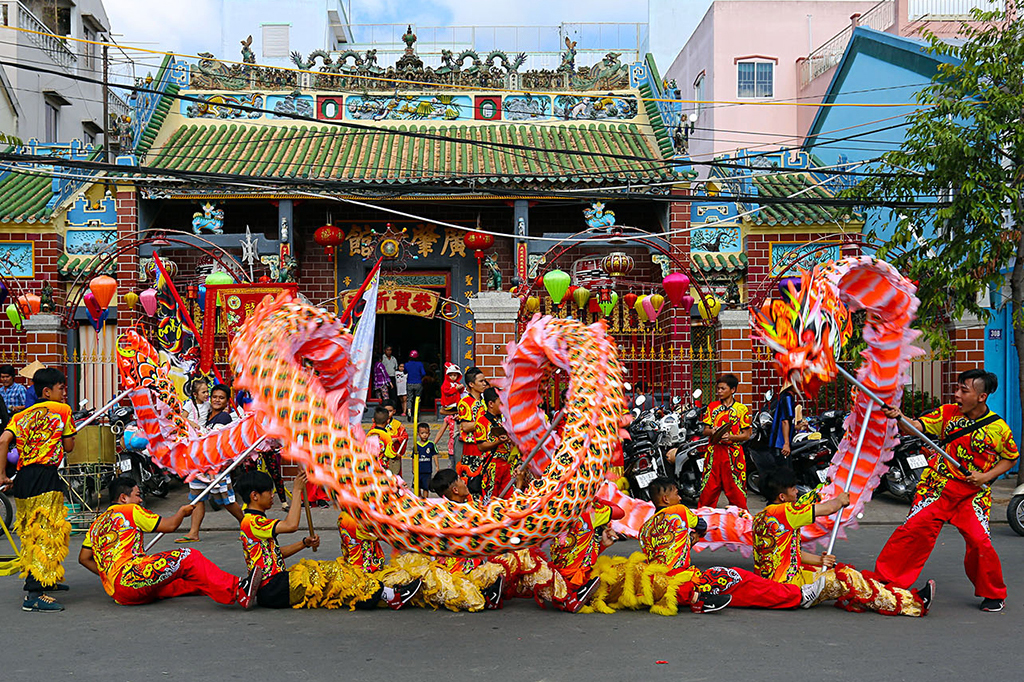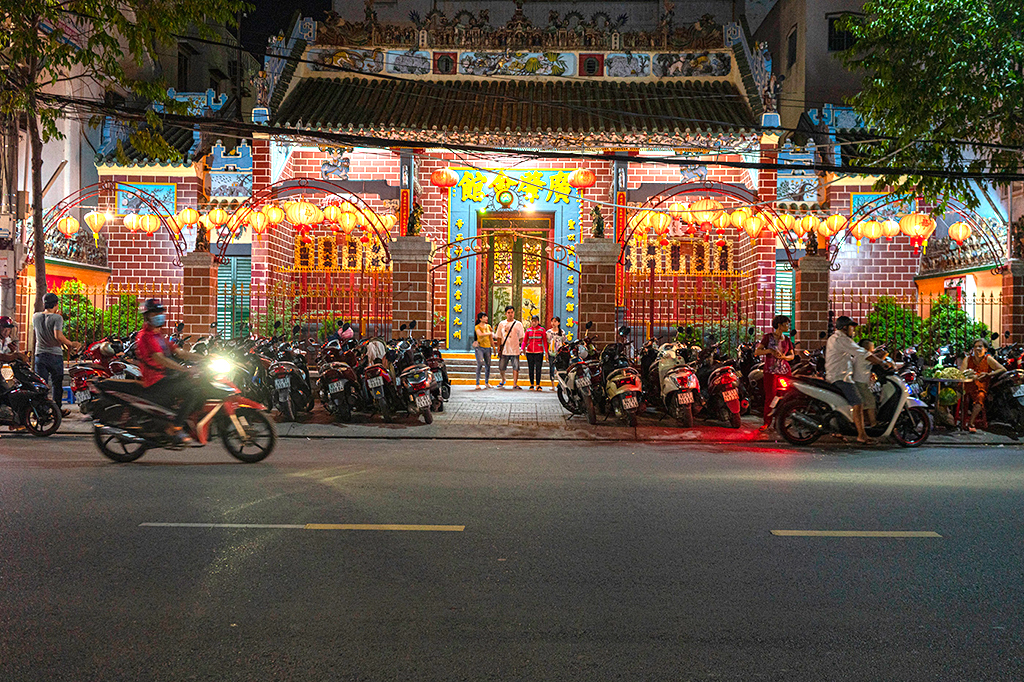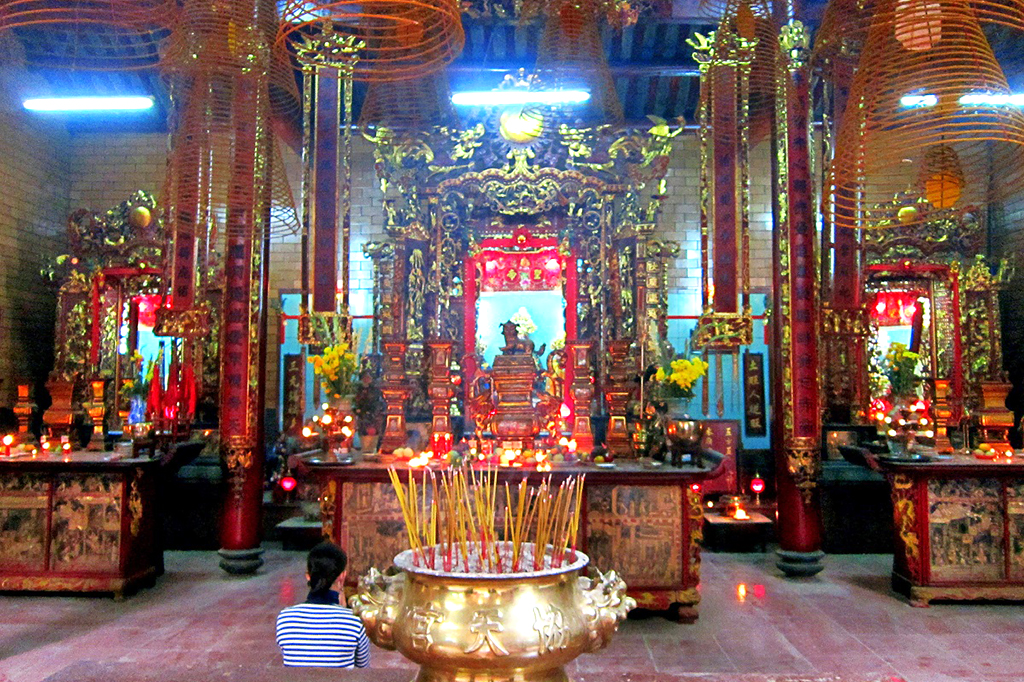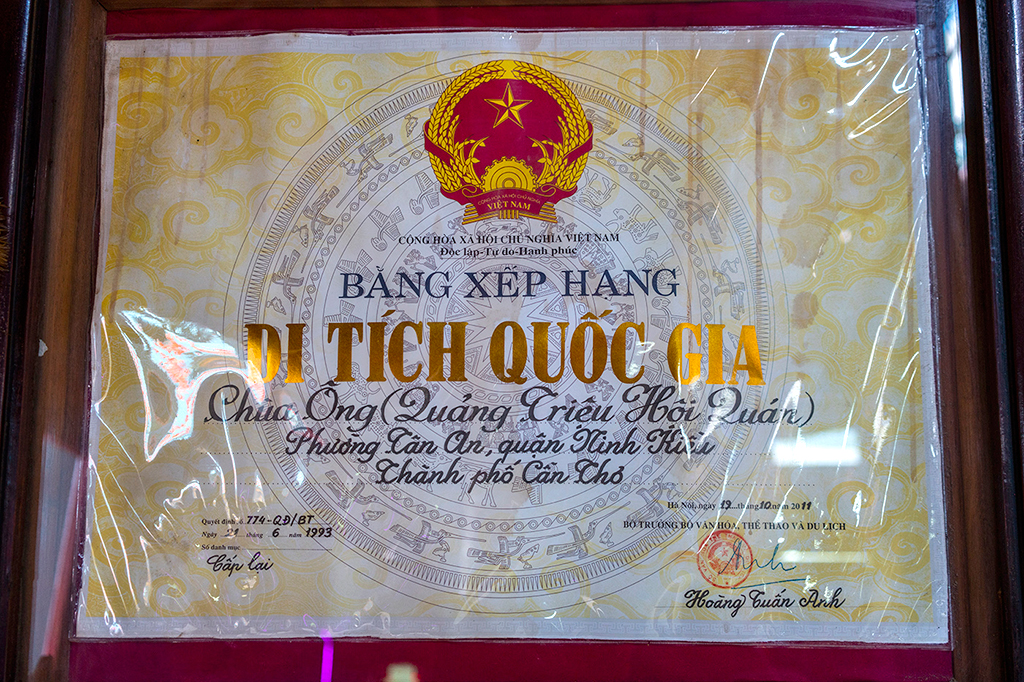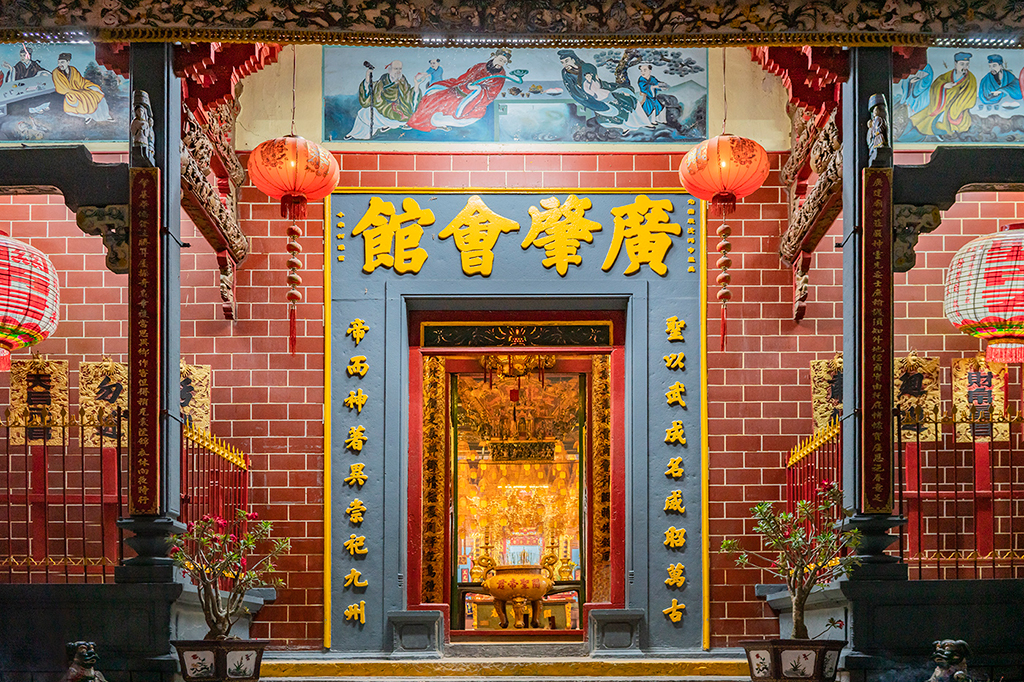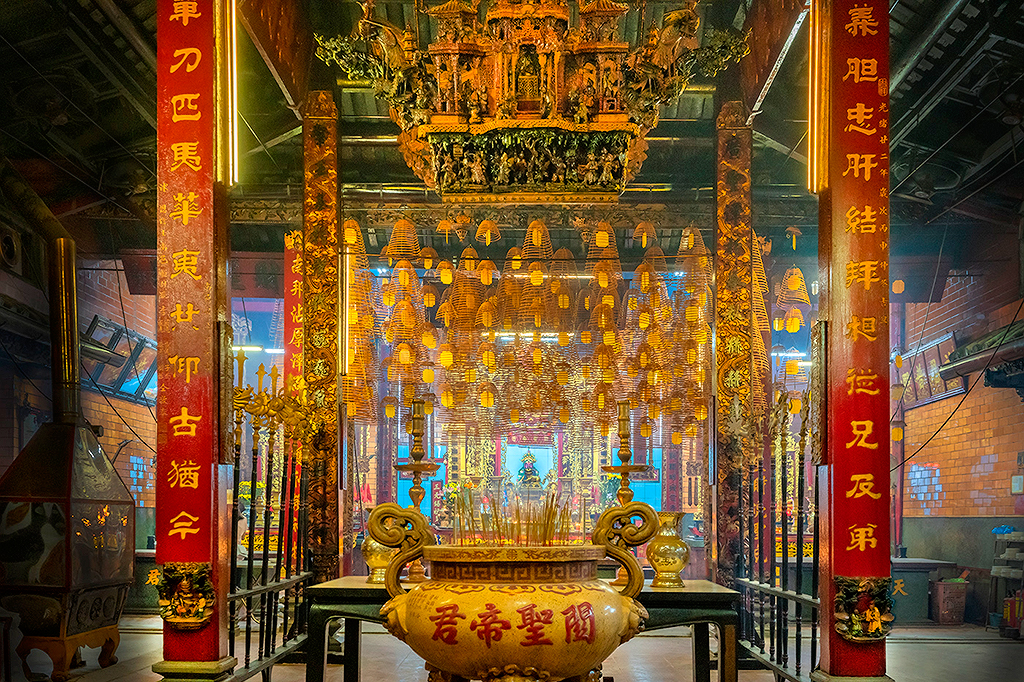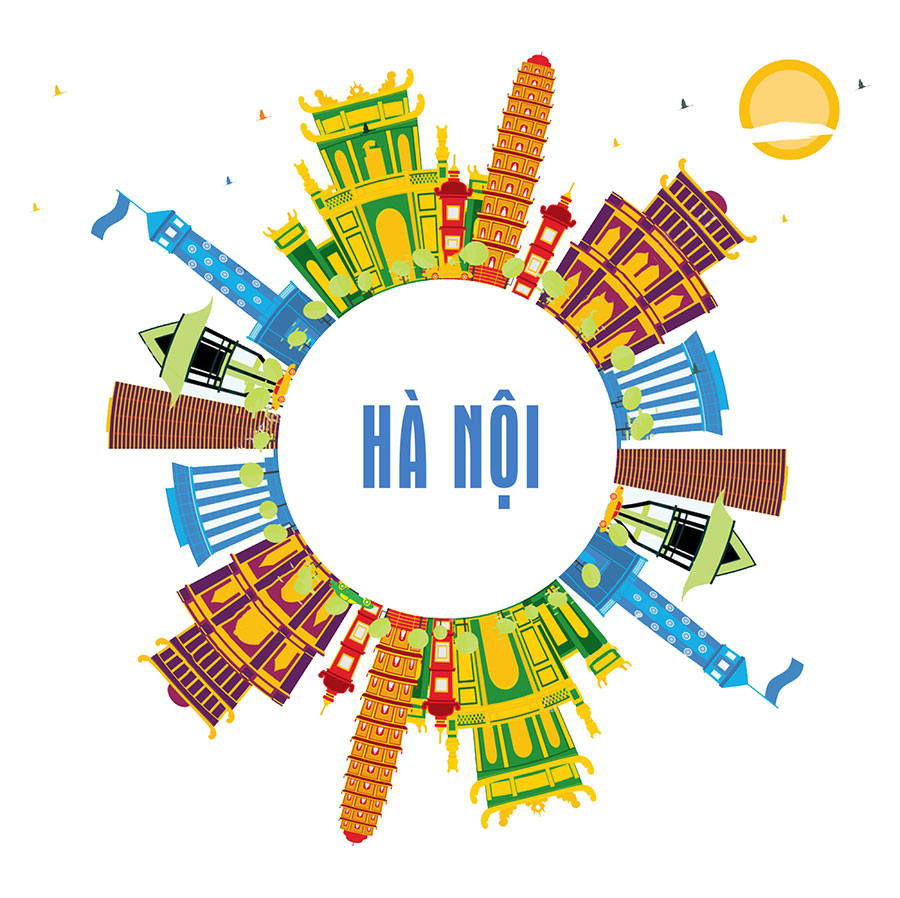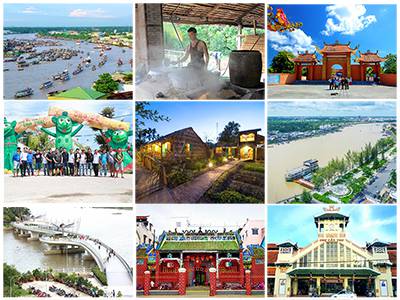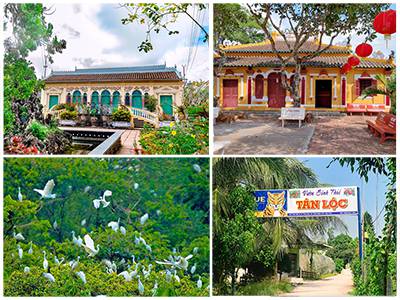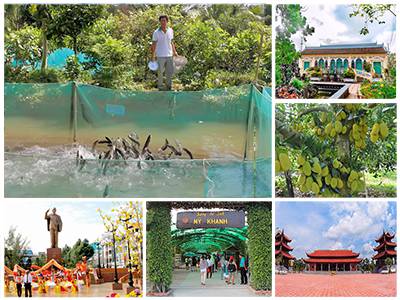Tourists to Can Tho City will be hooked to the harmony of architectures of Viet, Hoa (Chinese people - living in Viet Nam) and Khmer. Among them is the OngPagoda in Ninh Kieu wharf. It is a structure, which is beautiful and ancient, built with pure Chinese style architecture.
The Ong Pagoda is a common name for any religious place of the Chinese that are dedicated to the Kuan – Kung Deity. The design was built by a group of Chinese people coming from Quang Chau (Kuang - Thcheou) and Trieu Khanh (Tsao - Hun) Districts, Quang Dong (Kuang Tong) Province, China to share cultural activities and show their beliefs, which explains why it is called Kuang Tsao Assembly Hall (廣肇會館).
In the center of Can Tho City stands the OngPagoda with strong Chinese style architecture, which covers an area of 532sqm. The construction started in 1894 and finished in 1896. Much of the construction materials for this building were brought from China. The whole construction is designed in the shape of the Chinese character for
國 (Nation); it is built with rows of closed sections, perfectly square with each other. The center of the building is an empty space called tranquil celestial yard (sky well). The tiles in the roof are laid in alternate rows of double tiles. The joining materials are blue ceramic edges. The pagoda's roof is decorated with color pottery motips such as two dragons and a ball in between, fish transforming into dragon, phoenix, palaces, and human figures… showing scenes of festivities of the Chinese people. More specifically, there are two human figures on the two spears holding the Sun and the Moon, which symbolize yin and yang.
Entering the worship temple, visitors have to go through five steps made of stone and traditional wooden door with two drawings of God on both sides of the entrance. Inside the temple, there are three parts: The Front Worship Palace dedicated to the God of Fortune, General Ma Tien. Between the Front Worship Palace and the Main Worship Palace is a wooden screen used as a fence to guide guests around the Sanctuary, as going into in the middle is a sign of disrespect to the Gods.Joining the Front Worship Palace is the Celestial Yard , which is lower than other parts of the pagoda, covered with ridged tiles which can be opened to allow smoke from burning incense to get out of the building or closed to prevent from the rain and to adjust natural light. Visitors will see the shape of a boat for conveying humans from ignorance to enlightenment called “bat nha” hung in the center of the Middle Worship Palace. This boat is made of wood delicately carved to represent people. This is a special feature in Chinese pagodas.
The Main Worship Palace is the most important of all the three Palaces. It is here where there is a row of wooden framed altar tables, covered with glass to protect the bas-relief sculptures that are painted in gold. The sculptures depict daily activities such as carrying water with a bamboo sticks on a person's shoulder, cutting down trees and some marine life such as shrimps, crabs, and fish during the time of the Three Kingdoms in China. The temple was built to worship the Kuan – Kung Deity. This red face, five strains of long black bearded Deity in blue imperial robes symbolizes virtues of benevolence, civility, intellect and trustworthiness. These virtues are honored by the Chinese people. His altar was placed in the middle of the Main Worship Palace. On the right is the altar of Celestial Queen's Mother. On the left side are the altars of Honor Graduate Dong Vinh and the God of Finance. On the left - hand side is the altar of Bodhisattva Kuan – Yin (Bodhisattva of Mercy). These statues are made of wood, plaster and porcelain, made in the shape of a circle.
The gilded bas-relief sculpture is the most prominent feature in the Ong Pagoda. It plays a very important role in decorations. The high - relief sculptures sculpted in beams, truss, rafters, and columns detail legendary scenes from Chinese history. The low - relief sculpture contains carvings of apricots, orchids, daisies, bamboos, dragons, phoenixes, fish transforming into dragon and rices pike lets. The artists are not only brilliant in sculptures with delicate carvings but they are also able to show their talents in calligraphy. Two Chinese writing systems, “Trien” and “Thao”, were engraved on horizontal lacquered board, copper urns and bells to enhance the values of beauty and religious beliefs of the pagoda. In addition, the whole structure of the pagoda is made of rare wood with a system of complicated truss. The roof is supported by a six rows of square pillars, painted red. All of the pillars are placed on rocks, which are very firm. The walls are made of clay bricks but the ones for the gate pillar were made during the French Colonial rule. On each brick, “A-Julien α Ce… Soc Trang” was written.
On the daily basis The Ong Pagoda is honored to welcome many domestic and international visitors who come here to see, admire, and worship on the 15th of each lunar month, on the Celestial Queen's Mother, God of Fortune and God of Finance especially and Tết (Vietnamese New Year). Visitors should visit here (on June 24th of the lunar month) to attend the Kuan – Kung Deity's festival. Although the 15 minute - ceremony representing the culture of the common people, atmosphere is thrill with drum and trump, it is a very sacred and solemn ritual. Sacrifices consist of roasted pigs, roasted ducks, fruits, flowers, incenses, candles and votive paper objects of clothing and cap belonging to - Kuan – Kung Deity The Ông Pagoda is filled with not only Chinese people but also the Vietnamese. They all come here to pray for wealth, happiness and peace.
Besides the main events mentioned above, many other traditional events take place in the Ong Pagoda such as blessing and praying prior to the unicorn dance, lion dance, dragon dance, and lantern auction. The celebration takes place at the end of the lunar year or before the festival of sacred animal dance at the pagoda. The legend has it that all these sacred animals have souls shown in their eyes. Therefore, a good and lucky day prior to their performances is chosen to open the “Khai quang diem nhan” ceremony. The purpose of this celebration is to pray for all these animals to get blessings from Ong. With the blessings, they all are quick and courageous in every movements of their dance and especially their eyesight is better than usual. Lantern auction is organized only on inaugurations and anniversaries' of the founding Day of the school or Assembly Hall.
Not only the Chinese people in Can Tho but also residents of the Mekong Delta and Ho Chi Minh City come to the Ong Pagoda to make the atmosphere here livelier and happier. The lantern auction at the pagoda has a very humanitarian purpose because the money earned from this event is used for building Chinese schools, cemeteries, supporting schools for handicapped children, orphanages and restoring this pagoda. This is a very charitable event, which brings kindness and generosity to society by the Managing Board of the Ong Pagoda.
The Ong Pagoda plays an important role in the spiritual lives of the Chinese community in Can Tho. Apart from the values of architecture, this is a place where the Chinese people host other events such as meetings and organizing their own cultural activities. During the American war, the Ong Pagoda was a place to support the revolutionary forces fighting against the American troops, which has contributed to the success of the unification of the country. With those heritage values, Ministry of Culture and Information of Vietnam issued a Decision on June 21st, 1993 to recognize the Ông Pagoda as an architectural - art vestige./.
Nguyen Thi Ngoc Ngan
